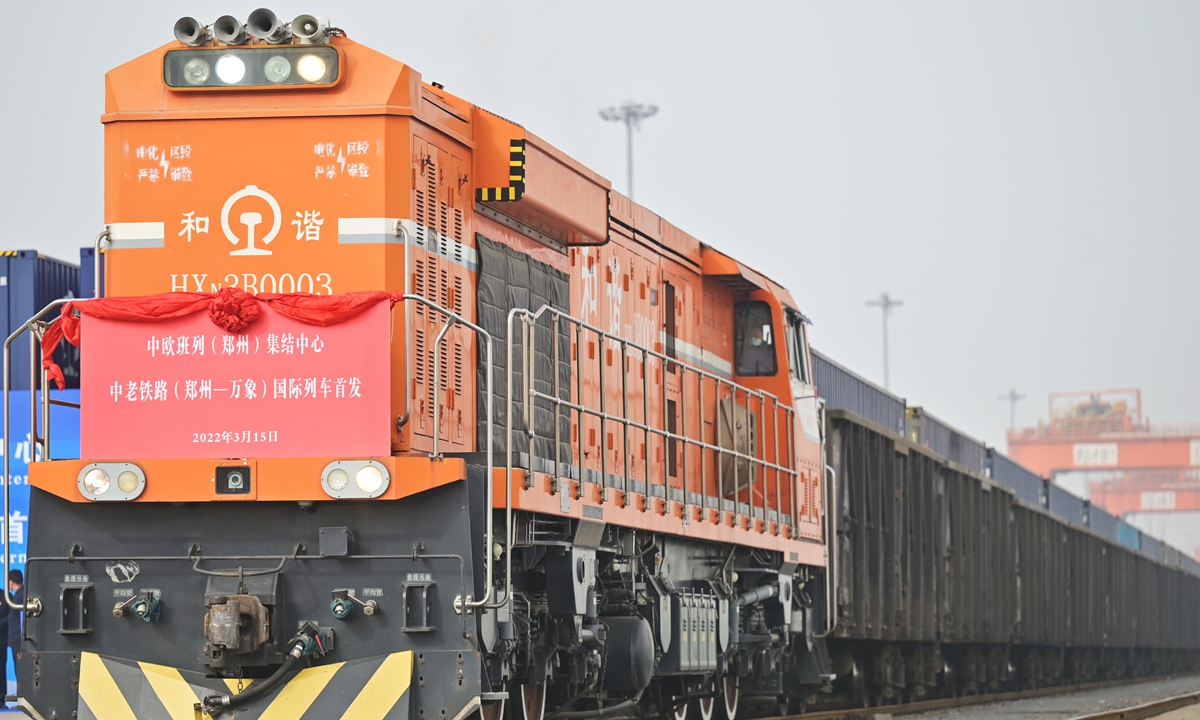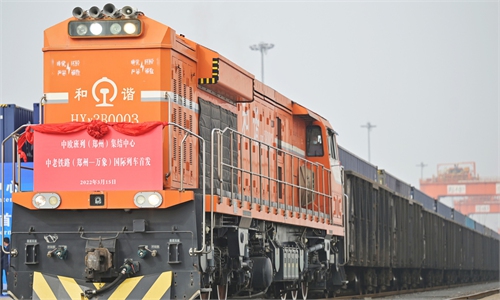
Logistics hub Zhengzhou, Central China’s Henan Province, sent its first international cargo train to Laos via the China-Laos Railway on March 15, 2022. The China-Laos Railway celebrated its 100th day of operation last week, having carried more than 1.2 million tons of goods and injected fresh momentum into economic and trade cooperation between China and ASEAN. Photo: VCG
A train loaded with a great variety of value-added goods such as bikes, lamps and ceramic tiles was dispatched from Chengdu’s air-rail international combined transport port, located in Southwest China’s Sichuan Province, on Sunday, before heading to Vientiane, capital of Laos, marking the first time blockchain technology was applied to the international intermodal chain.
The introduction of information sharing platform, backed up by blockchain technology, is expected to boost the efficiency of the cross-border transportation line.
A manager surnamed Huang with Haibang Logistics Co, one of the consignors of the goods delivered by this train, told CCTV news that with blockchain technology, both consignors and consignees will immediately be informed upon the arrival of goods, a fact that will improve the overall efficiency of transportation.
Blockchain technology can solve the problem of distrust in the international trade with traceability, which allows all parties involved including traders, customs and railway bureaus to share information on the platform and make the information more transparent, a person in charge of the digital finance department of China Railway Chengdu Bureau Group told the media.
The technological breakthrough in international transportation came along with the one-year anniversary of the launch of the China-Laos Railway, which was put into operation on December 3, 2021.
Over the past year, the Chengdu air-rail international intermodal port has operated a total of 61 China-Laos international trains, with a total of 1,250 TEUs being delivered. The main goods included refrigerators, diesel engines, ceramic tiles and rice mills.
Global Times
Read More: news.google.com









 Bitcoin
Bitcoin  Ethereum
Ethereum  Tether
Tether  XRP
XRP  Solana
Solana  USDC
USDC  Dogecoin
Dogecoin  Cardano
Cardano  TRON
TRON  Lido Staked Ether
Lido Staked Ether  Wrapped Bitcoin
Wrapped Bitcoin  Toncoin
Toncoin  Chainlink
Chainlink  LEO Token
LEO Token  Stellar
Stellar  USDS
USDS  Wrapped stETH
Wrapped stETH  Avalanche
Avalanche  Shiba Inu
Shiba Inu  Sui
Sui  Hedera
Hedera  Litecoin
Litecoin  Polkadot
Polkadot  MANTRA
MANTRA  Bitcoin Cash
Bitcoin Cash  Bitget Token
Bitget Token  Ethena USDe
Ethena USDe  WETH
WETH  Binance Bridged USDT (BNB Smart Chain)
Binance Bridged USDT (BNB Smart Chain)  Pi Network
Pi Network  Hyperliquid
Hyperliquid  Wrapped eETH
Wrapped eETH  WhiteBIT Coin
WhiteBIT Coin  Monero
Monero  Uniswap
Uniswap  Dai
Dai  Aptos
Aptos  NEAR Protocol
NEAR Protocol  Pepe
Pepe  sUSDS
sUSDS  OKB
OKB  Gate
Gate  Cronos
Cronos  Coinbase Wrapped BTC
Coinbase Wrapped BTC  Mantle
Mantle  Internet Computer
Internet Computer  Ethereum Classic
Ethereum Classic  Ondo
Ondo